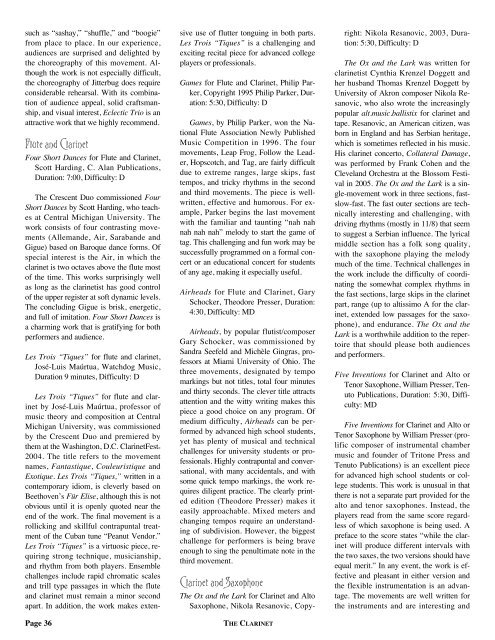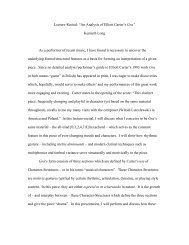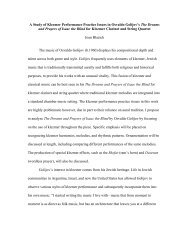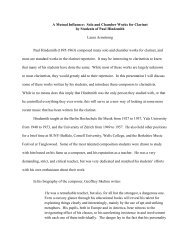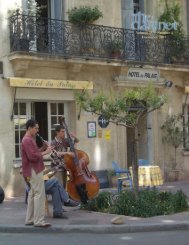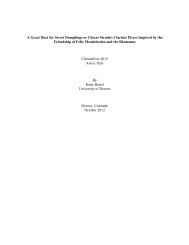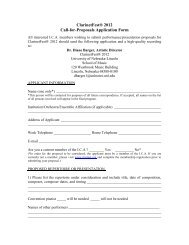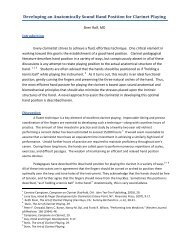Volume 33 Number 3 June 2006 - International Clarinet Association
Volume 33 Number 3 June 2006 - International Clarinet Association
Volume 33 Number 3 June 2006 - International Clarinet Association
- No tags were found...
You also want an ePaper? Increase the reach of your titles
YUMPU automatically turns print PDFs into web optimized ePapers that Google loves.
such as “sashay,” “shuffle,” and “boogie”<br />
from place to place. In our experience,<br />
audiences are surprised and delighted by<br />
the choreography of this movement. Al -<br />
though the work is not especially difficult,<br />
the choreography of Jitterbug does require<br />
considerable rehearsal. With its combination<br />
of audience appeal, solid craftsmanship,<br />
and visual interest, Eclectic Trio is an<br />
attractive work that we highly recommend.<br />
Flute and <strong>Clarinet</strong><br />
Four Short Dances for Flute and <strong>Clarinet</strong>,<br />
Scott Harding, C. Alan Publications,<br />
Dur ation: 7:00, Difficulty: D<br />
The Crescent Duo commissioned Four<br />
Short Dances by Scott Harding, who teach -<br />
es at Central Michigan University. The<br />
work consists of four contrasting movements<br />
(Allemande, Air, Sarabande and<br />
Gigue) based on Baroque dance forms. Of<br />
special interest is the Air, in which the<br />
clarinet is two octaves above the flute most<br />
of the time. This works surprisingly well<br />
as long as the clarinetist has good control<br />
of the upper register at soft dynamic levels.<br />
The concluding Gigue is brisk, energetic,<br />
and full of imitation. Four Short Dances is<br />
a charming work that is gratifying for both<br />
performers and audience.<br />
Les Trois “Tiques” for flute and clarinet,<br />
José-Luis Maúrtua, Watchdog Music,<br />
Duration 9 minutes, Difficulty: D<br />
Page 36<br />
Les Trois “Tiques” for flute and clarinet<br />
by José-Luis Maúrtua, professor of<br />
music theory and composition at Central<br />
Michigan University, was commissioned<br />
by the Crescent Duo and premiered by<br />
them at the Washington, D.C. <strong>Clarinet</strong>Fest®<br />
2004. The title refers to the movement<br />
names, Fantastique, Couleuristique and<br />
Exo tique. Les Trois “Tiques,” written in a<br />
con temporary idiom, is cleverly based on<br />
Beethoven’s Für Elise, although this is not<br />
obvious until it is openly quoted near the<br />
end of the work. The final movement is a<br />
rollicking and skillful contrapuntal treatment<br />
of the Cuban tune “Peanut Vendor.”<br />
Les Trois “Tiques” is a virtuosic piece, re -<br />
quiring strong technique, musicianship,<br />
and rhythm from both players. Ensemble<br />
challenges include rapid chromatic scales<br />
and trill type passages in which the flute<br />
and clarinet must remain a minor second<br />
apart. In addition, the work makes extensive<br />
use of flutter tonguing in both parts.<br />
Les Trois “Tiques” is a challenging and<br />
exciting recital piece for advanced college<br />
players or professionals.<br />
Games for Flute and <strong>Clarinet</strong>, Philip Par -<br />
ker, Copyright 1995 Philip Parker, Dur -<br />
a tion: 5:30, Difficulty: D<br />
Games, by Philip Parker, won the Na -<br />
tional Flute <strong>Association</strong> Newly Published<br />
Music Competition in 1996. The four<br />
move ments, Leap Frog, Follow the Lead -<br />
er, Hopscotch, and Tag, are fairly difficult<br />
due to extreme ranges, large skips, fast<br />
tempos, and tricky rhythms in the second<br />
and third movements. The piece is wellwritten,<br />
effective and humorous. For ex -<br />
am ple, Parker begins the last movement<br />
with the familiar and taunting “nah nah<br />
nah nah nah” melody to start the game of<br />
tag. This challenging and fun work may be<br />
successfully programmed on a formal concert<br />
or an educational concert for students<br />
of any age, making it especially useful.<br />
Airheads for Flute and <strong>Clarinet</strong>, Gary<br />
Schocker, Theodore Presser, Duration:<br />
4:30, Difficulty: MD<br />
Airheads, by popular flutist/composer<br />
Gary Schocker, was commissioned by<br />
San dra Seefeld and Michèle Gingras, professors<br />
at Miami University of Ohio. The<br />
three movements, designated by tempo<br />
markings but not titles, total four minutes<br />
and thirty seconds. The clever title attracts<br />
attention and the witty writing makes this<br />
piece a good choice on any program. Of<br />
medium difficulty, Airheads can be performed<br />
by advanced high school students,<br />
yet has plenty of musical and technical<br />
challenges for university students or professionals.<br />
Highly contrapuntal and conver -<br />
sational, with many accidentals, and with<br />
some quick tempo markings, the work re -<br />
quires diligent practice. The clearly printed<br />
edition (Theodore Presser) makes it<br />
easily approachable. Mixed meters and<br />
changing tempos require an understanding<br />
of subdivision. However, the biggest<br />
challenge for performers is being brave<br />
enough to sing the penultimate note in the<br />
third movement.<br />
<strong>Clarinet</strong> and Saxophone<br />
The Ox and the Lark for <strong>Clarinet</strong> and Alto<br />
Saxophone, Nikola Resanovic, Copy -<br />
THE CLARINET<br />
right: Nikola Resanovic, 2003, Dura -<br />
tion: 5:30, Difficulty: D<br />
The Ox and the Lark was written for<br />
clarinetist Cynthia Krenzel Doggett and<br />
her husband Thomas Krenzel Doggett by<br />
University of Akron composer Nikola Re -<br />
sanovic, who also wrote the increasingly<br />
popular alt.music.ballistix for clarinet and<br />
tape. Resanovic, an American citizen, was<br />
born in England and has Serbian heritage,<br />
which is sometimes reflected in his music.<br />
His clarinet concerto, Collateral Damage,<br />
was performed by Frank Cohen and the<br />
Cleveland Orchestra at the Blossom Fes ti -<br />
val in 2005. The Ox and the Lark is a single-movement<br />
work in three sections, fastslow-fast.<br />
The fast outer sections are technically<br />
interesting and challenging, with<br />
driving rhythms (mostly in 11/8) that seem<br />
to suggest a Serbian influence. The lyrical<br />
middle section has a folk song quality,<br />
with the saxophone playing the melody<br />
much of the time. Technical challenges in<br />
the work include the difficulty of coordinating<br />
the somewhat complex rhythms in<br />
the fast sections, large skips in the clarinet<br />
part, range (up to altissimo A for the clarinet,<br />
extended low passages for the saxophone),<br />
and endurance. The Ox and the<br />
Lark is a worthwhile addition to the repertoire<br />
that should please both audiences<br />
and performers.<br />
Five Inventions for <strong>Clarinet</strong> and Alto or<br />
Tenor Saxophone, William Presser, Ten -<br />
uto Publications, Duration: 5:30, Dif fi -<br />
culty: MD<br />
Five Inventions for <strong>Clarinet</strong> and Alto or<br />
Tenor Saxophone by William Presser (prolific<br />
composer of instrumental chamber<br />
music and founder of Tritone Press and<br />
Tenuto Publications) is an excellent piece<br />
for advanced high school students or college<br />
students. This work is unusual in that<br />
there is not a separate part provided for the<br />
alto and tenor saxophones. Instead, the<br />
players read from the same score regardless<br />
of which saxophone is being used. A<br />
preface to the score states “while the clarinet<br />
will produce different intervals with<br />
the two saxes, the two versions should have<br />
equal merit.” In any event, the work is ef -<br />
fective and pleasant in either version and<br />
the flexible instrumentation is an advantage.<br />
The movements are well written for<br />
the instruments and are interesting and


